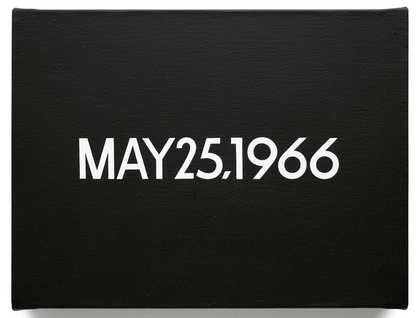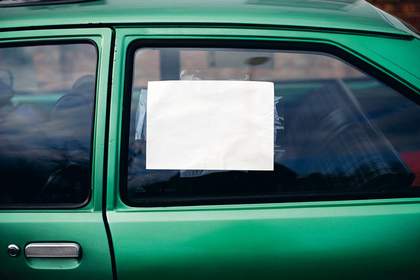
David Batchelor
Islington, London 01.05.99
Courtesy the artist and Anthony Wilkinson Gallery, London
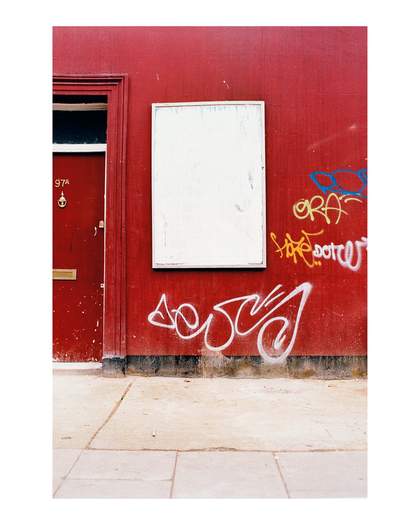
David Batchelor
Photograph 2. Stoke Newington, London 20.09.02
Courtesy the artist and Anthony Wilkinson Gallery, London
My original motives for making monochromes – back in the late 1980s – were vaguely malicious. The subject was interesting because it seemed to be pretty much the dumbest kind of painting that it is possible to make. A single uninterrupted plane of flat unmodulated colour spread evenly across a given surface – a monochrome appears to involve no composition, no drawing, no subtlety; and it requires no skill, and certainly no craft skill, to make one. Anyone who can paint a door can paint a monochrome. Or, as El Lissitzky put it in 1925: “Now the production of art has been simplified to such an extent that one can do no better than order one’s paintings by telephone from a house painter while one is lying in bed.” This was painting as low comedy, the reductio ad absurdum of high abstraction. Having said that, a part of what attracted me to the monochrome was also the awareness that for many artists this form of painting had promised a great deal more – the freeing of colour from the tyranny of line, the liberation of painting from the register of representation and the possibility of a brush with some sublime void or other metaphysical nothingness. It’s just that I didn’t believe that anyone could still seriously maintain its claims to transcendence, be they formal, spiritual or otherwise.
So there was the monochrome: born in revolution (around 1920, say, in the tussles between Malevich, Rodchenko, Lissitzky and others); grown through tricky adolescence to some kind of ambiguous respectability in the 1950s and 1960s (think Yves Klein, Piero Manzoni, Lucio Fontana in Europe; Ad Reinhardt, Robert Rauschenberg, Ellsworth Kelly in the US; Hélio Oiticica in Brazil, etc.); and now old, fat and bloated, come to die as corporate decoration in the boardrooms and marble foyers of every other steel and glass office block, hanging over the head of the CEO like a halo, only rectangular and usually grey. At least, that’s what I thought, back then. In truth it was difficult to think of that many actual corporate monochromes, but I loved the image none the less and that, for a while, was good enough for me.
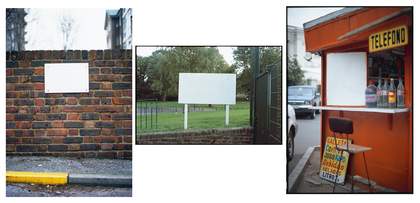
Left to Right: 4. Elephant and Castle, London, 20.02.98 5. Victoria Park, London, 23.11.08 6. Quinta Normal, Santiago, Chile, 31.03.05
Courtesy the artist and Anthony Wilkinson Gallery, London
The monochromes I started making began life as paintings, gradually turned into reliefs and then, after a few years of flailing around, ended up on the floor as objects. The first ones were black. They turned white over time, became silver for a while and occasionally went red – out of embarrassment I suspect. And all the while there was this nagging question: if the monochrome was so simple, why was this all taking so long? In retrospect, I realise one of my many difficulties was I had an idea of what I wanted without any obvious sense of what these things might actually be made from – which is only a problem if you are working in a studio surrounded by materials of one kind or another, and with some space to fill in an as yet unspecified and perhaps entirely imaginary gallery. Which is another way of saying that in art ideas are often much tidier creatures than objects. And then, to cut a rather long and very dull story short, at some point in the early 1990s my monochromes tripped up on a couple of readymades and stumbled into some colour. And in the process they began, just possibly, to have a life of their own, rather than one I had dreamed up for them.
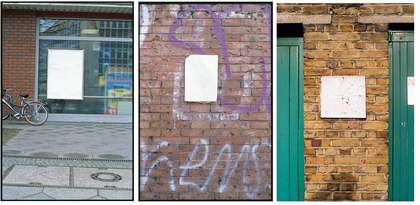
Left to right: 7. Alexanderplatz, Berlin, 04.04.08 8. Ponte Lungo, Rome, 17.04.07 9. King's Cross, London, 18.11.07
Courtesy the artist and Anthony Wilkinson Gallery, London
In 1997 I also began taking photographs of what I called “found monochromes” in the streets around where I lived in London. My initial thought was that I would somehow refute a thesis I had recently heard being made by Jeff Wall in a lecture on the work of On Kawara. Wall had presented a rather vivid account of the history of modernism as the history of two opposed forces unable fully to escape each other and equally unable to be reconciled with one another. These forces were embodied in the painting of modern life, on the one hand, and high abstraction on the other, and they had found form in photojournalism and the monochrome, respectively. As I understood it, he appeared to be saying that, in its logic of exclusion and emptying out, the monochrome was in some structural way unable to engage with or embody the experience of modernity. That seemed a very plausible argument – except I just didn’t buy it. So I went out into the street, literally, with the aim of finding evidence that the city is actually full of monochromes, that modernity is a precondition of the monochrome and that, in all its artificiality, the city is the monochrome’s natural habitat, an unacknowledged museum of the inadvertent monochrome. None of which, I now realise, necessarily refuted Wall’s thesis, but never mind.
On 17 November 1997 I photographed a monochrome I found on a street in King’s Cross, near where I lived at the time. It was off-white and cracked, but I thought it would do the job if I could find another four or five to go with it. But then, slowly, or maybe not so slowly, something happened. I found there was something strange and rather compelling about these readymade blanks. And from time to time I found new ones. So I photographed them too. And in the process I learned a few things: a found monochrome has to be a blank surface in the street, but not just any blank surface. It has to be rectangular or square, vertical, white and in some sense inadvertent, unplanned, or temporary. For it to work, the monochrome has somehow to detach itself from its surroundings. That’s why white is better than black or other colours (I photographed some reds and blues and yellows too, early on). And in detaching itself from the surroundings, by being white and parallel to the picture plane, the monochrome plane can begin to form a small empty centre in an otherwise saturated visual field. A bit of nothing – but more nothing-much than nothing-ness; a presence that is more like an absence, at least for a moment or two. Or, to put it another way, the monochrome became more interesting – more ambiguous, more uncertain – than I had been prepared for it to be. Rather than just a dumb blank or just a bit of exotic emptiness, it appeared that it might occasionally be both, or it might somehow flicker between the two mutually exclusive alternatives. A plane and a void. But not a mysterious void-in-general, rather a contingent void, a void in a place, here, today, on this particular railing in this particular street; here today, and probably gone tomorrow. A void in a place, but not in every place: these incidents are not, I noticed, distributed evenly throughout the city; they have a tendency to cluster in more overlooked and transitional environments, and are scarce in more refined and elegant districts. For me, and perhaps only for me, these bits of peripheral vision are little heroic moments, small monuments to modernity – if modernity can still, in part, be defined in that great phrase of Baudelaire’s as ‘the ephemeral, the fugitive and the contingent’.
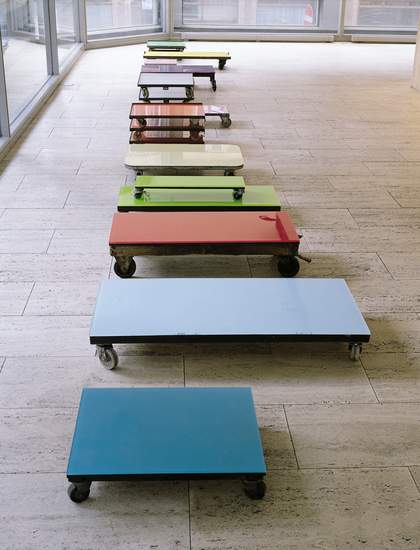
David Batchelor
I Love King's Cross and King's Cross Loves Me 1996- 1997
Found dollies, acrylic sheet, enamel paint
Dimensions variable
Private Collection. Photo: David Batchelor
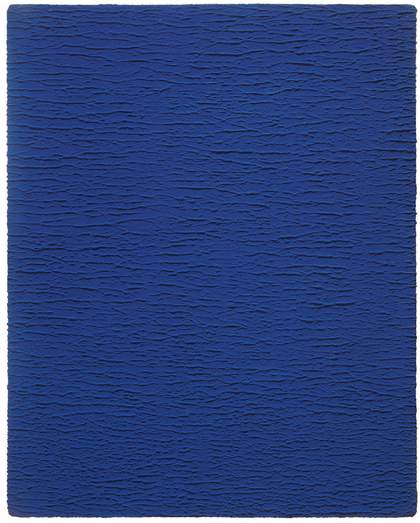
Yves Klein
Untitled Monochrome Blue IKB 67 1959
Oil on canvas
92 x 73 cm
Courtesy Yves Klein archive
Since 1997 I have found versions of these occasional void-planes in areas of London and in just about every other city I have travelled to. There were around 400 at the last count. I have come to think of the series as an openended project that changes shape as it grows and can be exhibited in a number of forms – as a slide show, as individual prints, as an installation of images pasted on a wall in a grid. Together the series forms a map of sorts: a city map; an autobiographical map; a mildly psychogeographical map; and a map that principally indicates the location of something that is no longer there.

